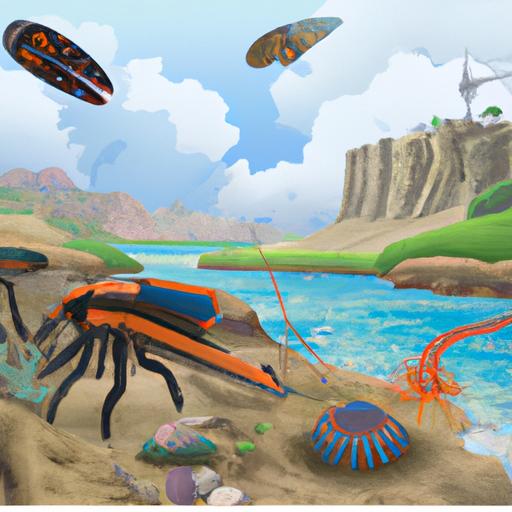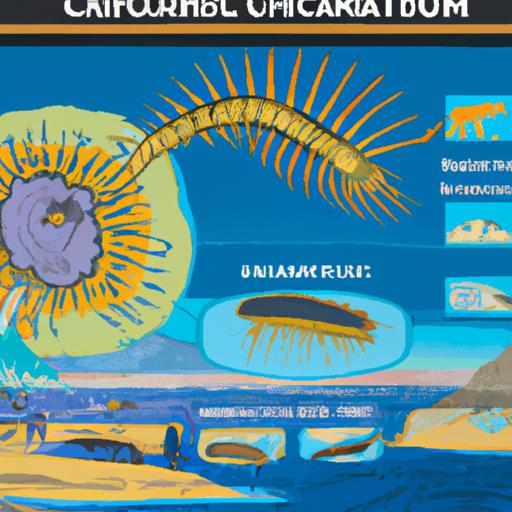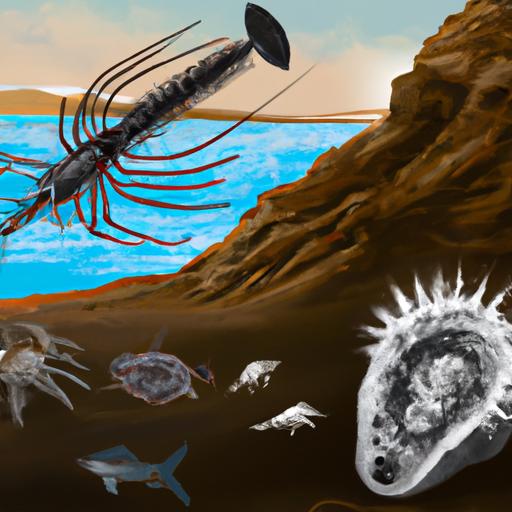This article may contain factual errors. It was created by the openai-ghostwriter 1.0.1. This is a python script for automatic generation of web pages powered by the OpenAI's GPT-3.
Dieser Artikel kann Unsinn und falsche Aussagen enthalten! Er wurde vom openai-ghostwriter 1.0.1 erzeugt. Das ist ein Python-Skript für die vollautomatische Erstellung von Webseiten.
The Cambrian Explosion

The Cambrian Explosion is a period of rapid evolutionary development that occurred during the Cambrian Period, which lasted from 541 to 485 million years ago. During this time, the number and diversity of life on Earth increased dramatically. This event marked the beginning of the Phanerozoic Eon, which is the current eon in Earth's history. The Cambrian Explosion is sometimes referred to as the "Big Bang" of evolution because it marks a major turning point in the history of life on our planet.
Prior to the Cambrian Explosion, life on Earth was relatively simple. Most organisms were small and single-celled, living in shallow seas. There were no animals with hard body parts or complex organs. During this period, known as the Precambrian Era, life changed very slowly over millions of years.
The Cambrian Explosion changed all that. In a relatively short period of time, new forms of life began to appear in the fossil record. These included animals with hard shells and complex organs such as eyes and brains. This sudden burst of evolutionary activity is thought to have been caused by an increase in oxygen levels in Earth's atmosphere and oceans.
This event marked a major turning point in Earth's history because it allowed for more complex forms of life to evolve. It also led to an increase in competition between species for resources such as food and space. This competition drove further evolution and diversification among species.
The Cambrian Explosion has been studied extensively by scientists since its discovery in 1859. It has provided important insights into how evolution works and how new species can arise quickly when conditions are right. It has also helped us understand how ecosystems can change rapidly over time.
Today, we can still see evidence of this event all around us. Many modern animals have their origins in this period, including humans. The diversity of life on our planet today is largely a result of this incredible event that occurred millions of years ago.
Introduction
 The cause of the Cambrian Explosion is still debated by scientists. Some believe it was due to a sudden increase in oxygen levels in the atmosphere, while others suggest it was caused by an increase in genetic diversity or changes in ocean chemistry. Whatever the cause, it is clear that this event had a profound impact on the evolution of life on Earth.
The cause of the Cambrian Explosion is still debated by scientists. Some believe it was due to a sudden increase in oxygen levels in the atmosphere, while others suggest it was caused by an increase in genetic diversity or changes in ocean chemistry. Whatever the cause, it is clear that this event had a profound impact on the evolution of life on Earth.
Background Information
Before the Cambrian Explosion, life on Earth was mostly composed of single-celled organisms such as bacteria and archaea. These organisms had been present for billions of years, but they were not very diverse. During this time, there were no multicellular animals or plants. However, during the Cambrian Explosion, this changed dramatically. Over a period of about 10 million years, there was an unprecedented diversification of life forms, with many new phyla appearing in the fossil record. One possible explanation for this sudden burst of evolution is that environmental conditions changed suddenly and dramatically during this time period. This could have caused an increase in competition between species, leading to an evolutionary arms race as species adapted to their changing environment. Another possible explanation is that there was a sudden increase in oxygen levels in the atmosphere during this time period, which allowed for more complex forms of life to evolve. The Cambrian Explosion also saw the development of hard body parts such as shells and exoskeletons. This allowed some species to become much better at protecting themselves from predators and other environmental threats. It also allowed them to move more quickly and efficiently through their environment, increasing their chances for survival. The Cambrian Explosion had a profound effect on the evolution of life on Earth. It marked the beginning of an era in which complex animals began to appear and diversify rapidly. The event also led to an increase in biodiversity and complexity among living things, allowing for further evolution and adaptation over time. Today, many scientists believe that we are currently experiencing another “explosion”—the Anthropocene Extinction Event—which is caused by human activities such as deforestation and climate change. This event is causing mass extinctions at an unprecedented rate, with some estimates suggesting that up to half of all species could be lost by 2100 if current trends continue. The Cambrian Explosion was a pivotal moment in Earth’s history that set off a chain reaction leading to today’s diverse array of living things. Without it, we would not be here today—and neither would any other complex organism on our planet.Definition of Cambrian Explosion
Before the Cambrian Explosion, most organisms were single-celled and relatively simple in form. During this period, however, many new species appeared in a relatively short amount of time. This sudden diversification of life forms is known as adaptive radiation and is thought to have been caused by a combination of environmental changes and genetic mutations. The most visible evidence of the Cambrian Explosion can be seen in the fossil record. Fossils from this period show an unprecedented variety of organisms with complex body plans and organs. These include animals such as trilobites, brachiopods, mollusks, and echinoderms. Many of these creatures had hard shells or exoskeletons that allowed them to be preserved in the fossil record. The Cambrian Explosion also marked a major shift in evolutionary theory. Prior to this period, scientists believed that evolution was slow and gradual. However, the sudden appearance of so many new species challenged this idea and forced scientists to reconsider their theories about how evolution works. Today, scientists are still trying to understand what caused the Cambrian Explosion. One popular theory suggests that it was triggered by an increase in oxygen levels in Earth’s atmosphere. This allowed for more complex organisms to evolve due to increased metabolic activity. Other theories suggest that competition between species may have played a role in driving evolutionary change during this period. As different species competed for resources, those with advantageous traits would have been more successful at surviving and reproducing. Regardless of its cause, there is no doubt that the Cambrian Explosion was an incredibly important event in Earth’s history. It marked a dramatic increase in biodiversity and set the stage for modern life on our planet.Evolutionary Causes
 The Cambrian Explosion has been studied extensively by scientists in order to understand how and why it happened. While the exact causes are still unknown, it is believed that a combination of environmental factors and genetic mutations led to the rapid evolution of new species during this time. By studying this event, scientists can gain insight into how evolution works and how it has shaped life on Earth.
The Cambrian Explosion has been studied extensively by scientists in order to understand how and why it happened. While the exact causes are still unknown, it is believed that a combination of environmental factors and genetic mutations led to the rapid evolution of new species during this time. By studying this event, scientists can gain insight into how evolution works and how it has shaped life on Earth.
Environmental Factors
One environmental factor that may have contributed to the Cambrian Explosion is an increase in oxygen levels. During this time period, oxygen levels rose significantly due to increased photosynthesis from ocean-dwelling algae. This increase in oxygen allowed for more complex forms of life to evolve, as higher levels of oxygen allowed for larger and more active organisms. Additionally, higher levels of oxygen allowed for the development of new metabolic pathways and behaviors, such as predation. Another environmental factor that may have contributed to the Cambrian Explosion is an increase in nutrient availability. During this time period, there was an increase in nutrients available to organisms due to increased volcanic activity and tectonic plate movement. This increase in nutrients allowed for more complex forms of life to evolve, as they had access to more resources than before. Additionally, these nutrients may have provided a competitive advantage for some species over others, leading to rapid evolutionary change. A third environmental factor that may have contributed to the Cambrian Explosion is an increase in temperature. During this time period, global temperatures were much higher than they are today due to increased volcanic activity and greenhouse gas emissions from early organisms. This increase in temperature allowed for more active organisms with higher metabolic rates to evolve, as they were better able to take advantage of their environment’s resources. Additionally, this warmer climate may have encouraged species diversification by providing different habitats for different species. Finally, a fourth environmental factor that may have contributed to the Cambrian Explosion is an increase in sea level. During this time period, sea levels rose significantly due to melting glaciers and other factors. This rise in sea level allowed for more land area to be exposed and colonized by organisms, leading to increased competition between species and rapid evolutionary change. In conclusion, while there are many theories about what caused the Cambrian Explosion, one popular explanation is that environmental factors played a role. Specifically, increases in oxygen levels, nutrient availability, temperature and sea level all likely contributed to this sudden burst of evolution by providing new opportunities for organisms and encouraging species diversification.Genetic Changes
One possible explanation for the Cambrian Explosion is genetic changes. During this period, there was a rapid increase in genetic complexity, which allowed for more diverse and complex organisms to evolve. This increased complexity could have been due to changes in gene regulation or mutations that allowed for new traits to be expressed. For example, some researchers believe that the development of Hox genes may have played an important role in allowing animals to develop more complex body plans. These genes are responsible for controlling the development of different body parts and organs, so they could have enabled animals to develop more specialized structures. Another possible explanation for the Cambrian Explosion is environmental factors. During this period, Earth's climate changed drastically, leading to an increase in oxygen levels and other environmental conditions that were favorable for animal evolution. This could have provided an opportunity for organisms to diversify and adapt quickly to their new environment. Additionally, competition between species may have also played a role in driving evolutionary change during this period. Finally, another potential cause of the Cambrian Explosion is mass extinction events. During this period, several mass extinction events occurred which wiped out many existing species and opened up new niches for other organisms to fill. This could have allowed animals with new adaptations or traits to take advantage of these newly available resources and rapidly diversify. In conclusion, while there is still much debate surrounding what caused the Cambrian Explosion, it is likely that multiple factors were involved including genetic changes, environmental factors, and mass extinctions events. Each of these forces likely played an important role in driving evolutionary change during this period and allowing for a greater diversity of life forms than ever before.Impact on Life

The Cambrian Explosion was a period of rapid evolutionary development that occurred around 540 million years ago. This event marked the beginning of the Paleozoic era and saw the emergence of most major animal phyla. It is believed that this event was caused by an increase in oxygen levels, which allowed for more complex life forms to evolve. The Cambrian Explosion had a profound impact on life as we know it today, as it set the stage for the evolution of many species that still exist today. It also allowed for the diversification of life on Earth, leading to the incredible diversity of species that we see today.
